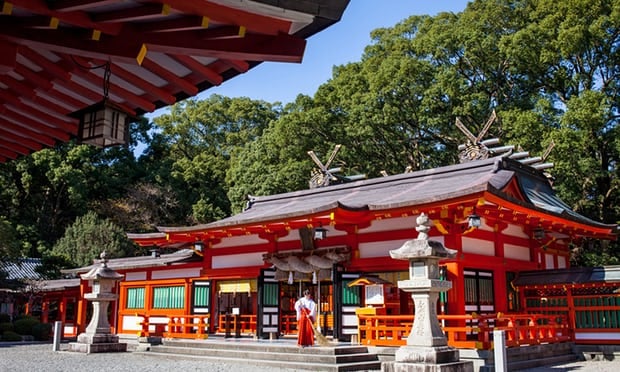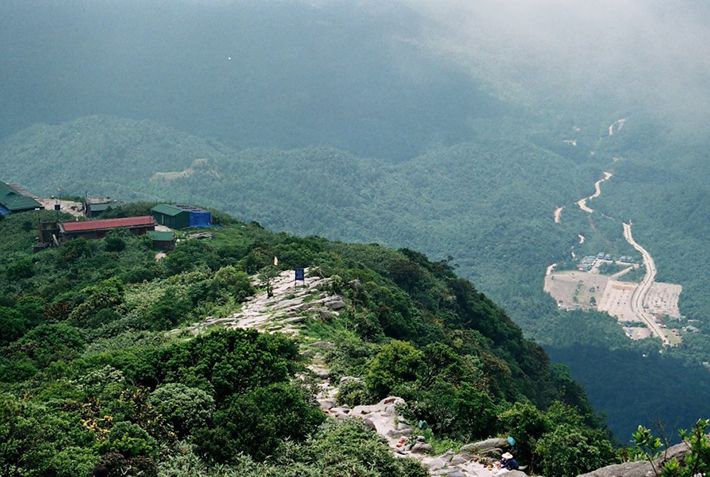Below are some famous pilgrimage routes.
Kumano Kodo Iseji, Japan
The Kumano Kodo Iseji Pilgrimage Route is an ancient route with a total length of about 170km, connecting Kumano Sanzan with Ise-jingu Shrine. This route has a long history, and has been worshiped since the Edo period until today. Recognized by UNESCO as a world heritage site in 2004, this is the most famous ancient pilgrimage route in Japan and passes through many breathtaking landscapes such as rivers, waterfalls, forests and mountains.


The Kumano region has long been considered sacred as the birthplace of Japanese culture and spirituality. Many people even call it “the abode of the gods”. The three main shrines on this route are Kumano Hongu Taisha, Kumano Hayatama Taisha and Kumano Nachi Taisha. Each shrine has a long tradition and is a great heritage of Japan.
Santiago de Compostela, Spain
The Santiago de Compostela Pilgrimage Route, also known as the Way of St. James, stretches from the border with France and Spain to the city of Santiago de Compostela. The pilgrimage route has up to 1,800 buildings, churches, and historical structures, which are evidence of religion and the development of Christianity. At the same time, it also plays an important role in the cultural and religious exchange between the Iberian Peninsula and other places in Europe during the Middle Ages.
In addition to its historical and religious value, it also represents the development of European architectural art over many centuries. The architectural heritage represents the birth of the Romanesque art school, Gothic churches and a chain of monasteries.
The pilgrimage route has several different routes, but all lead to the Cathedral of Santiago de Compostela, where the tomb of St. James is said to be located. The tomb is believed to date back to the 7th century, but it was not until the 9th century that the exact location of the tomb in Compostela was known. The tomb's fame then spread rapidly throughout Europe, and people began making pilgrimages to Santiago de Compostela as early as the 10th century.
Mecca, Saudi Arabia
When mentioning the word “pilgrimage”, perhaps the name Mecca is the first place that comes to mind. This sacred land is located in the center of Arabia, the center of Muslim beliefs. Many people believe that the pilgrimage to Mecca, especially during the largest pilgrimage called Hajj, is the most important journey of a person’s life.

Every year, hundreds of thousands of Muslims gather and perform rituals. They walk around the Ka'aba cube seven times in a counterclockwise direction; drink water from the Zamzam well; throw stones at the Satanic pillars at Jamarat; spend a night at Muzdalifa; run back and forth between the hills of Al-Safa and Al-Marwah.
Yen Tu, Vietnam
January 10th every year is considered the official opening day for the entire 3-month Yen Tu Spring Festival, with tens of thousands of pilgrims a day. Coming here, visitors not only simply attend a large traditional religious festival to pray for blessings and luck in the new year, but also have the opportunity to learn about the largest Buddhist center in the history of Vietnamese religion.

Yen Tu Mountain is 1,068m above sea level, belongs to Dong Trieu mountain range, located on the border of Bac Giang and Quang Ninh provinces. The total road length to reach the top of Yen Tu (Dong Pagoda) is about 6,000m with 6 hours of continuous walking through thousands of stone steps and winding mountain forest roads. In the more than 2,000-year flow of Vietnamese Buddhism, Yen Tu is a place associated with the name and life of Buddhist King Tran Nhan Tong - the founder of Truc Lam Zen - a Zen sect with strong national Buddhist identity. And this "spiritual" area is also the "capital" of Buddhism in ancient Dai Viet.

In particular, the Dong Pagoda located on the top of Yen Tu is cast entirely of pure copper, which is the place that brings unforgettable emotions. Dong Pagoda is located on the top of Yen Tu mountain, with the word name Thien Truc Tu, named after the country of Buddha Tathagata, in accordance with the "supreme" position of Yen Tu peak. At the location of Dong Pagoda today, there used to be a small-scale bronze pagoda. In the pagoda, there is a statue of Bodhisattva Avalokitesvara, bells and worship objects are all made of bronze.
Ngoc Anh (TH)


































